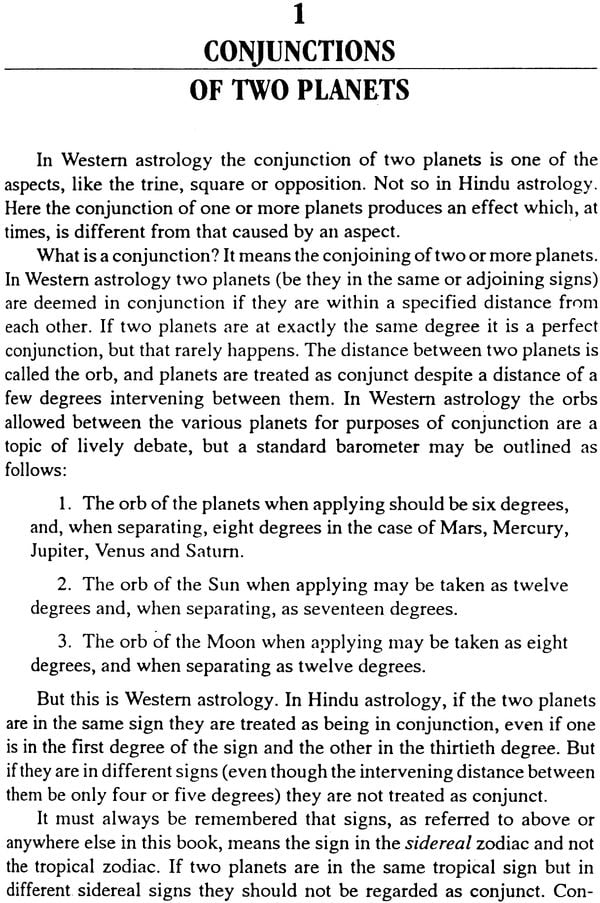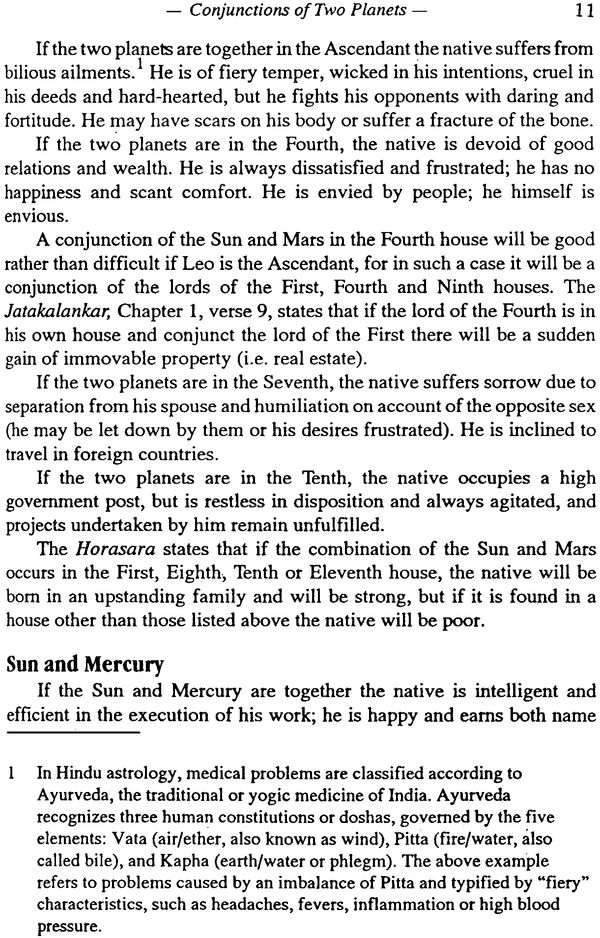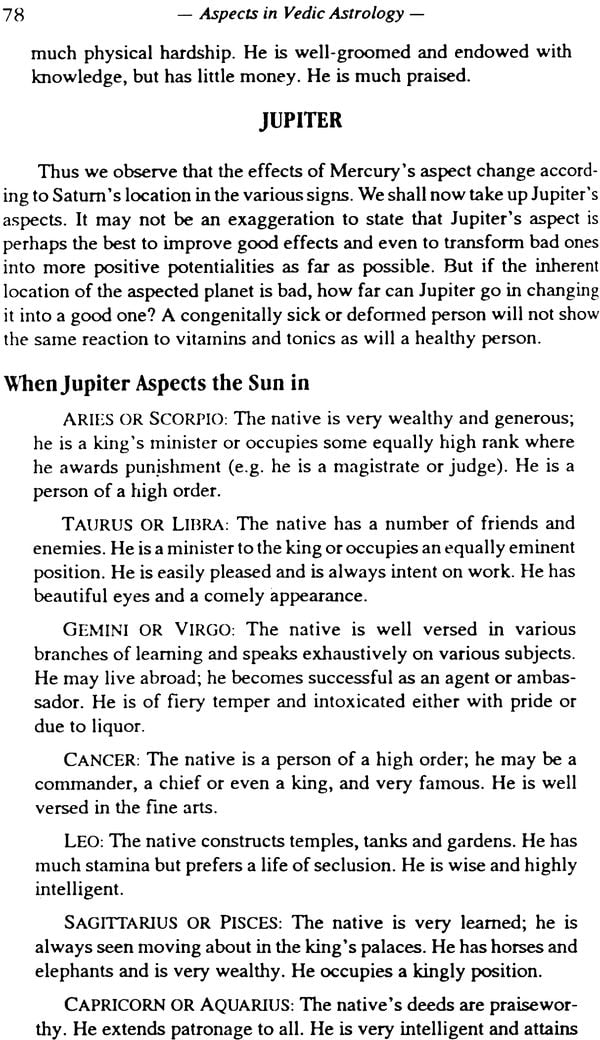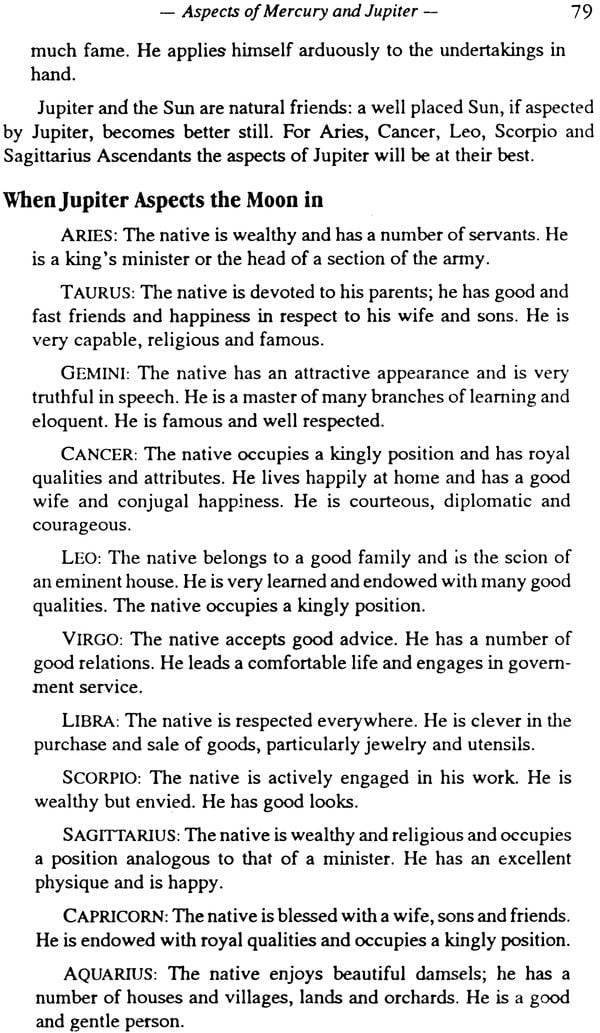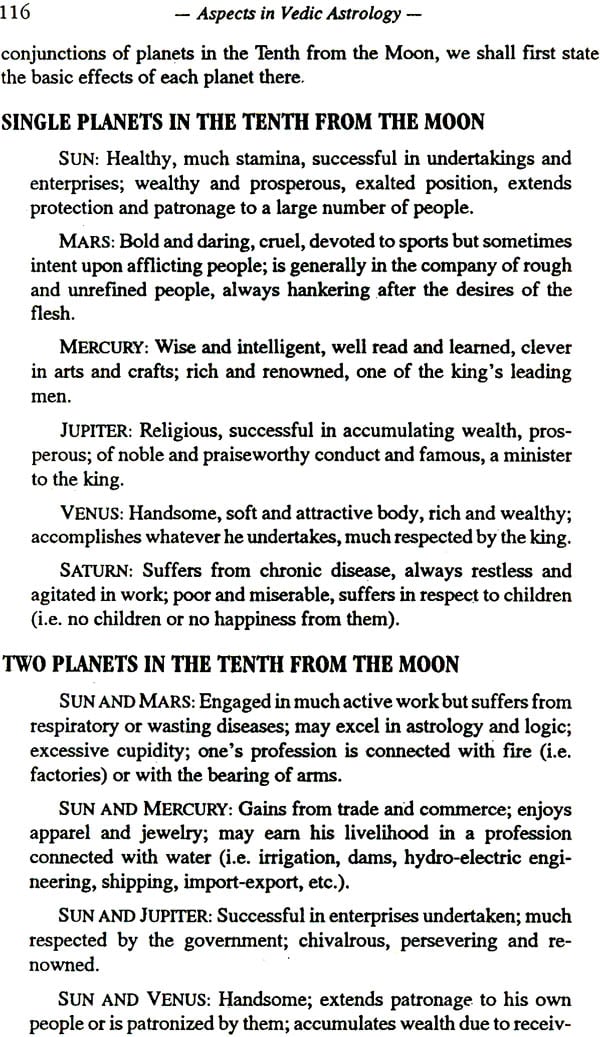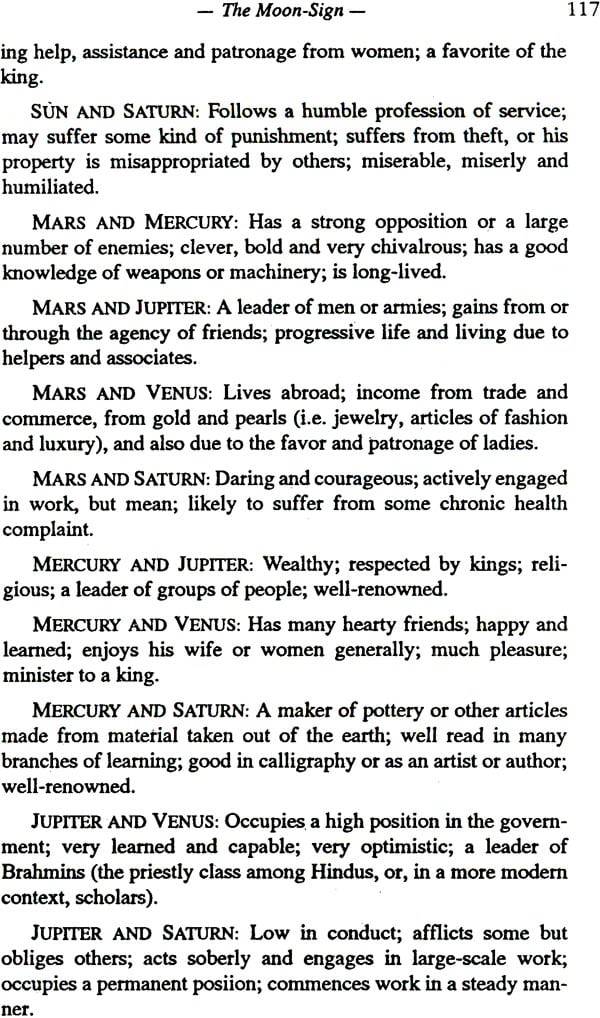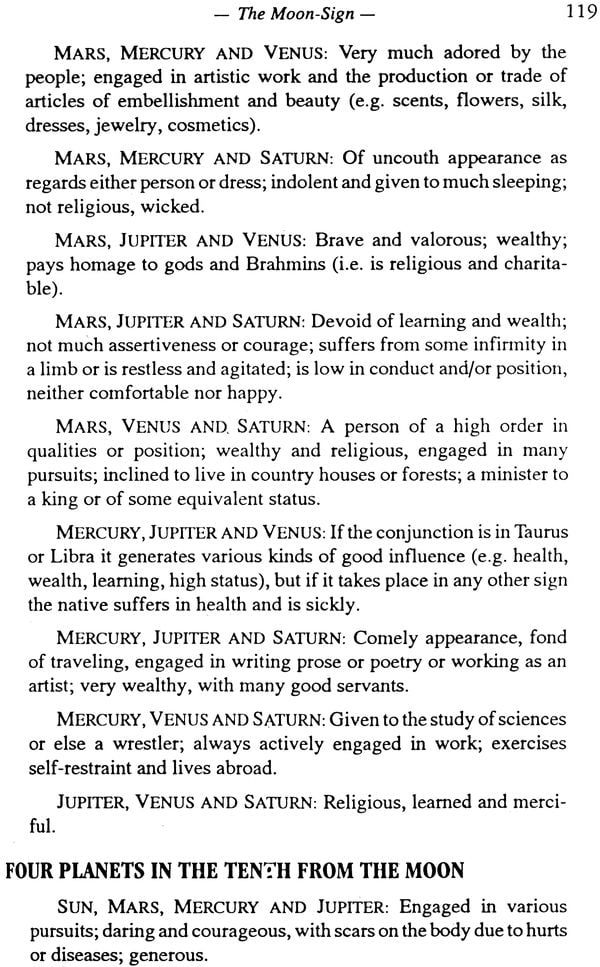
Aspects in Vedic Astrology
Book Specification
| Item Code: | IDD332 |
| Author: | Gopesh Kumar Ojha and Ashutosh Ojha |
| Publisher: | Motilal Banarsidass Publishers Pvt. Ltd. |
| Language: | English |
| Edition: | 2003 |
| ISBN: | 9788120819283 |
| Pages: | 192 |
| Cover: | Paperback |
| Other Details | 8.5" x 5.6" |
Book Description
About the Book
Though astrologers are well aware that it is the aspects between planets which add detail and definition to a birth chart, there has been (until now) no single work which deals comprehensively with the theory and delineation of aspects in Vedic astrology. This book fills a void by providing a clear and concise treatment of the subject.
The authors have drawn their material from the ancient and medieval classics of Vedic astrology, preserving the wisdom of the sages as well as granting their reader a wealth of insight into how the ancient dictums may be applied to contemporary life.
About the Author
Pandit Gopesh Kumar Ojha was a great scholar and pioneer in writing books on Vedic Astrology, physionomy, palmistry and various branches of Samudrik Shastra. Many of his books on Astrology are used as text books in India.
Pandit Ashutosh Ojha has a number of books on Astrology to his credit. He holds a degree in Mathematics and a Masters degree in English Literature. He has been intensively practising and teaching Astrology. He has a clientele spread out in more than one hundred and thirty-five countries.
About the Book
Though astrologers are well aware that it is the aspects between planets which add detail and definition to a birth chart, there has been (until now) no single work which deals comprehensively with the theory and delineation of aspects in Vedic astrology. This book fills a void by providing a clear and concise treatment of the subject.
The authors have drawn their material from the ancient and medieval classics of Vedic astrology, preserving the wisdom of the sages as well as granting their reader a wealth of insight into how the ancient dictums may be applied to contemporary life.
About the Authors
Pandit Gopesh Kumar Ojha was a great scholar and pioneer in writing books on Vedic Astrology, physionomy, palmistry and various branches of Samudrik Shastra. Many of his books on Astrology are used as text books in India.
Pandit Ashutosh Ojha has a number of books on Astrology to his credit. He holds a degree in Mathematics and a Masters degree in English Literature. He has been intensively practising and teaching Astrology. He has a clientele spread out in more than one hundred and thirty-five countries.
Preface
Brahma is the Guru for He is the Creator of the Vedas which in their turn destroy our ignorance and illuminate the mind; Vishnu is the Guru for He resides in our heart and Upbrings us; Mahaeshwar is Guru for He is the Protector. Guru is the Supreme Power of Godhead Personified and I bow to Him.
Astrology and for that matter no knowledge is attained without the Blessings of the Guru. The importance of Astrology is the same in the Vedas as that of the eyes in the body. It is used at all places and at all times not only to see the past, present and future but also to time the event to an auspicious moment in order to ensure success. Even when performing 'yagyas' (fire sacrifice), plucking up the plants for making medicine, planting, starting education, marriage, religious ceremonies, Astrology plays the most important role.
One who approaches with humbleness and full faith, with an open mind to gain knowledge, only he is able to establish a rapport with the Teacher so that the Transmission of knowledge takes place. Some persons gain faster as the illumination is not the same in everyone. This invisible link is also present in twins who transmit feelings and learning to each other. In our experiment with twins, one of the twins said, "What my sister learned for many years came to me when we were 38-year old."
This book of Aspects in Vedic Astrology deals with the effects of Aspects between different planets. The interpretation is presented in a simple manner so that even those who are at the threshold of Astrology have no difficulty in following it.
A planet in a house has a certain interpretation. For example, Jupiter in the fourth house endows one with property, happiness, high position, success and a happy old age. However, if the aspect of Mars takes place with Jupiter then the interpretation is changed. Fights and losses due to unwise investments and frauds, can take place. People who understand chemistry even a little bit know that the changes in the proportions of Chemicals when mixing them together will give different results which are totally different. The same is true of the aspect between planets. A shade of blue and a shade of yellow will be green whereas as shade of blue with a shade of red will be violet. In will be neither blue nor yellow nor red.
All planets exert certain influence on living and non-living things. At times we notice that to some person the same type of aspects show very good results whereas in case of others the result is totally negligible. The reason is not far to seek. The following factors may be the cause;
1. The radical position of planets.
2. The lordships of the planets from the Ascendant and from the Moon.
3. The strength of the Lord of the Ascendant, Sun. Moon and the lord of the ninth house.
4. The horoscope of the father, mother, brothers and sister an the people we associate with in any capacity.
5. The relationship of the native with the significators; of that planet.
6. What holds true of the planets at birth also holds good of the aspects between them during Transit. For example, one who has an aspect between Mars and Saturn at birth, will feel the intensity of it when they aspect each other during transit. This aspect between the two occurs after every two years and lasts for six to seven weeks. In transit due consideration be given to the Vedh (Obstruction when certain planet nullifies the effect. Good and bad both when transiting a particular house from the planet in question).
7. The country, the times and the person, all of them or even one modifies the effects; in developed countries very few people the of hunger and poverty; With the times new inventions and gadgets of efficiency, the space and weather and disease etc. have been controlled; The background of the person, the walk of life one comes from etc., as well as the age factors, modify and influence the results of a chart.
8. General trends due to important astrological aspects and configuration.
In this book after a brief introduction to Astrology we have discussed the effects of the aspects and configuration of two, three and more planets. It is followed by aspects of Sun. Moon and Mars on other planet posited in different sings; conjunction of two or three planets in the ninth house; Jupiter in the ninth house and the effects of the aspect of other planets on it. The eighth chapter deals with what planets signify and the placement of one, two, three or four planets in the tenth house from the Moon.
In ninth chapter important combinations for longevity, wealth, prosperity, relationships, marriage, friends, enemies, prosperity and other departments of life have been discussed.
The tenth chapter is devoted to the thirteen principles for judgment. In the end we have added the following Appendices:
Appendix I: influence of planets viz., Uranus, Mercury, Neptune etc. in transit because they bring about a change in the general trends which in turn effects the individual charts.
Appendix II: deals with the influence of Uranus and its aspect with other planets.
Appendix III: deals with the effects of Neptune and the aspect that Neptune forms with other planets.
We are sure that after going through this book of Aspects, the readers will be well equipped to understand the resultant effects of the configurations between different planets. The effects of Uranus, Neptune, Pluto etc. is added because without this the book will not be complete in itself.
Brahma turns a beggar into a King, a king into a beggar; a wealthy man into man and a poverty stricken person into a rich man.
Introduction
The science of the heavens is broadly divided into two branches astronomy and astrology. Astrology itself has many branches mundane astrology, which deals with rains, meteorology, crops, storms, floods and droughts, fires, volcanic eruptions, seismic disturbances, natural calamities and disasters, etc.; political astrology, dealing with the rise and fall of nations, kings and empires, riots, wars, changes of government and the like; commercial astrology, involving the rise and fall of prices, scarcity or abundance of commodities, inflation or deflation in stocks and shares, bullion, food, famine and pestilence; electional astrology, which deals with the selection of the appropriate time for commencement or consummation of a particular work of importance; and natal astrology, pertaining to birth times and nativities. Then there is horary astrology and the system of annual solar returns, solar ingresses, monthly solar returns, lunar returns, daily returns and a vast astrological literature on transits. Even in natal astrology there are three branches; esoteric astrology deals with the question "why," while directions, transits, mahadashas and antardashas (called bhuktis in South India), along with many other methods, address the intricate and complex problem of "when." Parashara, the father of Hindu astrology, discusses forty-three kinds of mahadashas and Jaimini, another old master, about a dozen. There is a vast literature on the subject. But the basic principle in the Western as well as the Hindu system is that only those things come to pass which are ordained in the radix (the birth chart and the root of all predictions), and scholars all over the world, in the past as well as in the present, have devoted much time, energy and experience to the question of "what" in the context of natal astrology. Even this "what" is not easy or simple to define. It embraces sings and subdivisions, the Ascendant and the other houses, and planets their state, strength and modalities, various planetary patterns (called yogas in Hindu astrology). Conjunctions and aspects, etc. our experience, which is shared by many astrologers, has been that the "when" in astrology is based on calculations which, though involving protracted time and energy, are made easy due to their conforming to mathematical processes, but the "what" requires a delicate balancing of, at times, paradoxical indications, and it is to help in this balancing that the conjunctions and aspects prove a helpful and reliable guide.
In Western astrology most textbooks ideal with conjunctions and aspects along with other matters. Mr. C. E. O. Carter, in addition to writing several books such as The Principles of Astrology and Some Principles of Horoscopic Astrological Delineation, also thought fit to write a whole book entitled The Astrological Aspects, devoted exclusively to the conjunctions and aspects of planets. According to this late celebrated British astrologer (and many would share his conviction, as we do), the conjunctions and aspects play a pivotal role in the matter of predictions. And yet we have not come across any book dealing exclusively with the subject from the point of view of Hindu astrology. True, the standard works written in Sanskrit during the ancient and medieval periods touch on the matter, but the guidelines are scarce and scattered. And it is with a view to filling this void that we have, in this book, condensed the cream of knowledge collected from about twenty standard Sanskrit works of outstanding authority and repute.
A book dealing with the subject according to the canons of Hindu astrology is not a luxury but a necessity, for more reasons than one. First a larger and larger number of astrologers in the West, professional as well as amateur, are taking an interest in Hindu astrology. Second, even for Indian scholars there is no single book dealing with the subject in such detail. In the Hindu and Western systems there are some fundamental differences in approach to the subject. Most Western books delineate evil effects for square and opposition aspects, except Mr. Carter, who states that "inharmonious aspects cause misfortunes but they do not forbid success." Similarly most of the Western writers from the middle Ages onward have called trines and sextiles good. But Mr. Carter makes an exception here also, and calls these aspects inharmonious if the planets involved are of contrary nature. In Hindu astrology, however, as readers will observe, the criteria are quite different. Astrologers following the Hindu system have available a large literature in English to supplement their own knowledge with that of the West, but there is no detailed book in English projecting the fundamental image of Hindu astrology in the matter of aspects.
With this in view, the present book has been written, and we have picked and chosen out of what the old master wrote in Sanskrit and what has been reinforced by our own experiences during forty-eight years of astrological practice. If readers will bestow their attention upon the precepts in this guide, our efforts will be amply rewarded.
Our effort has been not just to collect gems from the old masters and string them together, but to offer our comments and criticism at every relevant stage to help our readers to better understand and appreciate the astrological significance of particular aspects. The cardinal principles provided by the conjunctions and aspects are valuable for general appraisal as well. And if we have invited attention to a particular feature at more than one place, it has been to emphasize it so that the readers may better assimilate it.
It must be added, for the guidance of our Western readers, that Hindu astrology is based on the sidereal zodiac, and that the tropical longitudes of the Ascendant and the planets must be converted into sidereal ones for appraisal of the influence of conjunctions and aspects as given in this book.
| 1 | Preface | vii |
| Introduction | 1 | |
| 1 | 1. Conjunction of Two Planets | 9 |
| Conjunction of the Sun; Conjunction of the Moon; Conjunction of the Mars; Conjunction of the Mercury; Conjunction of the Jupiter | ||
| 2 | Conjunction of Three Planets | 27 |
| Conjunction of the Sun; Conjunction of the Moon; Conjunction of the Mars; Conjunction of the Mercury; Jupiter; Venus and Saturn | ||
| 3 | Multiple Conjunctions | |
| Conjunction of Four Planets: The Sun, The Moon, Mars, Mercury, Conjunction of Five Planets; The Sun, The Moon, Mars Conjunction of Six Planets; Conjunction of Seven Planets; Harmony and Heterogeneity; Conjunctions Leading to Asceticism: Four Planets, Five Planets, Six Planets, Yogas | ||
| 4 | Aspects of the Sun, Moon and Mars | 53 |
| Aspects of the Sun, Aspects of the Moon; Aspect of Mars | ||
| 5 | Aspects of Mercury and Jupiter | |
| Aspects of Venus; Aspects of Saturn | ||
| 6 | Aspects of Venus and Saturn | 87 |
| Aspects of Venus; Aspects of Saturn | ||
| 7 | The Ninth House | 103 |
| Conjunctions of Two Planets; Conjunctions of Three Planets; Jupiter in the Ninth | ||
| 8 | The Moon-Sign | 111 |
| Single Planets in the Tenth from the Moon; Two Planets in the Tenth from the Moon; Three Planets in the Tenth From the Moon; Four Planets in the Tenth from the Moon | ||
| 9 | Important Combinations | 121 |
| Health and Diseases; Longevity; Heart and Mind; Relations, Friends and Enemies; Marriage and "The Pleasures of the Bed"; Wealth, Luck and Prosperity; Real Estate; Vehicles; Status and Position | ||
| 10 | Judgment Guidelines | 157 |
| Appendices | ||
| Appendix I: Influence of Planets | 176 | |
| Appendix II: Influence of Uranus and Its Aspects with Other Planets | 177 | |
| Appendix III: Effects of Neptune and the Aspect | 181 |

